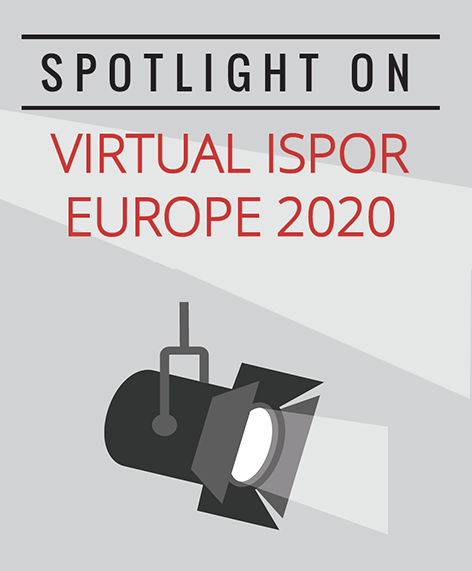Accounting for Caregiver Burden in HEOR
Aakash Bipin Gandhi, BPharm, Department of Pharmaceutical Health Services Research, University of Maryland, Baltimore, MD, USA; and Vasco Pontinha, MPharm, MA, Department of Pharmacotherapy and Health Outcomes, Virginia Commonwealth University School of Pharmacy, Richmond, VA, USA
Certain diseases may contribute to a disproportionate amount of caregiver burden. Hence, the inclusion of caregiver utilities in a cost-utility analysis (CUA) may seem justified. However, there are several uncertainties regarding methods associated with their inclusion, measurement, and interpretation in CUA models.
Considering Caregiver Utilities in HTA
Panelist Noemi Muszbek, MSc, Visible Analytics, Reading, United Kingdom, (Figure 1) introduced the concept, importance, and implications of including caregiver utilities in a health technology assessment (HTA). Muszbek stated that “Informal care is an integral part of a patient’s disease management. However, this may have spillover effects on both caregivers and non-caregiving family members associated with the patient.” Hence, excluding these aspects from a CUA study may provide incomplete information on the effectiveness of a healthcare intervention. Despite this adverse implication, only a few value-assessment guidelines (eg, Norway) provide guidance on specific methods that can be used to incorporate caregiver utilities in a CUA framework. Since 2019, NICE has also begun including caregiver burden utilities in value assessments of treatments associated with rare, genetic, and congenital conditions.
Figure 1. Panelists (clockwise): Noemi Muszbek, Edit Remak, Andrew Lloyd, and Hareth Al-Janabi.

Muszbek also spoke about several challenges associated with quantifying the uncertainty in measuring caregiver utilities. These include quantifying the spillover effect of a patient’s disease on caregivers, determining how caregivers are affected by an intervention, and finding a suitable method to measure these effects. Direct elicitation methods such as standard gamble or time tradeoff and indirect elicitation methods may be used for this purpose. Additionally, are there carer health states or events that also need to be considered? Finally, ethical aspects should be considered as well, such as how one weighs the balance between effect on the carer and effect on the patient. Muszbek concluded by showing the mixed and complex response of HTAs in quantification of carer utilities. “HTAs seem to include theoretical considerations of caregiver utilities but fail to provide clear methodological guidance on their inclusion. Thus, more research and further discussions between payers, pharmaceutical companies, and HTA bodies are needed.”
Measuring Elicitation for Carers
Session moderator Hareth Al Janabi, Health Economics Unit, University of Birmingham, United Kingdom, discussed his research on preference-based outcomes measure elicitation for family carers, which was funded by the National Institute for Health Research of the National Health Service in the United Kingdom. Janabi stated that, “simply using quality of life measures like EQ-5D appear to be very common, but there are questions about whether it is valid for caregiver utility elicitation.” Thus, other measures like the Carer Experience Scale or ICECAP-A may be better suited, given the similar format to EQ-5D, and preference-based scoring weighting. A validity study comparing multiple utility measures identified ICECAP-A as the utility measure that best encapsulated aspects pertaining to both quality of life of the patient and caregiver. To conclude, Janabi stated that there is a strong case for inclusion of caregiver utilities in value assessments.
Quantifying Caregiver Burden
Panelist Andrew Lloyd, DPhil, Acaster Lloyd Consulting Ltd, London, United Kingdom discussed how caregiver burden can have a substantial impact on the social, physical, and physiological functioning for individuals providing care. It is important to quantify caregiver burden. Ultimately, Lloyd argues that the inclusion of caregiver utilities is a policy decision that should be considered by HTA bodies. That decision should even consider the possible correlation between disease severity and dependency on the caregiver, and the fact that existing data is likely an underreport of caregiver burden. For example, in pediatric conditions, it is possible that parents underreport the burden of caring for their children. Thus, it is important to generate longitudinal data that better reflects the true caregiving burden.
Certain ethical considerations need to be kept in mind when including caregiver burden in value assessments. According to Panelist Edit Remak, PhD, Visible Analytics, Budapest, Hungary, survival benefit for patients is also reflected in caregivers too, especially in severe diseases. Conversely, the survival of the patient can also mean that the “relief” to not perform caregiver duties is no longer present, creating this unacceptable scenario in which the death of the patient appears to be preferable. Thus, ethically, neither of these scenarios seem to be acceptable. Remak concluded by providing the example from Norway in which the focus of the caregiver burden is placed on the main differentiation factor between the status quo and the new health intervention.

